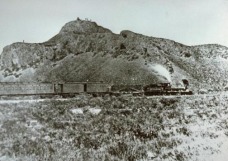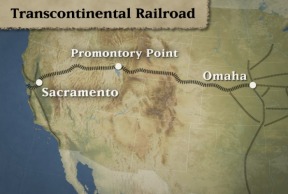The Transcontinental Railroad

Before the Civil War, no easy means of transportation existed between the east and west in the United States. The task seemed impossible. A transcontinental railroad would have to cover almost 2000 miles across the wide open plains inhabited by millions of buffalo and numerous Indian tribes. Two mountain ranges also stood in its path: the Sierra Nevadas in eastern California and the Rockies. No railroad company dared to risk the capital investment necessary for its construction. Also, there were few man willing to work so hard for so little. Therefore, the only way to complete such a daunting task was to involve the federal government. In 1862, Congress passed the Pacific Railway Act. Construction of the railroad would begin the following year. It would take another 6 years of non-stop building to complete.

The completion of the first Transcontinental Railroad in 1869 had a dramatic impact on the American West. During its construction, the Union Pacific would hire men to hunt the buffalo to feed its workers. This infuriated the Plains Indians would tried to defend their land from the iron horse by attacking railroad crews and derailing trains. The government would send the army to protect the crews, the construction would continue, and the buffalo would continue to die.
Although there are many other factors to consider, such as the lure of gold, silver and free land, the transcontinental railroad would have the greatest impact on the nation during the late 19th century because it made settlement on the Great Plains possible by allowing farmers and ranchers a means to ship their crops and livestock back east, which led to the slaughter of the buffalo and several wars with the Plains Indians, allowed Chicago, a crossroads between the East and West, to boom, and America’s economy and industry to flourish with the resources of the West, and brought easterners to Utah, ending Mormon isolation forcing them to change their religion/culture. Polygamy would be banned in Utah in 1896.
Although there are many other factors to consider, such as the lure of gold, silver and free land, the transcontinental railroad would have the greatest impact on the nation during the late 19th century because it made settlement on the Great Plains possible by allowing farmers and ranchers a means to ship their crops and livestock back east, which led to the slaughter of the buffalo and several wars with the Plains Indians, allowed Chicago, a crossroads between the East and West, to boom, and America’s economy and industry to flourish with the resources of the West, and brought easterners to Utah, ending Mormon isolation forcing them to change their religion/culture. Polygamy would be banned in Utah in 1896.
